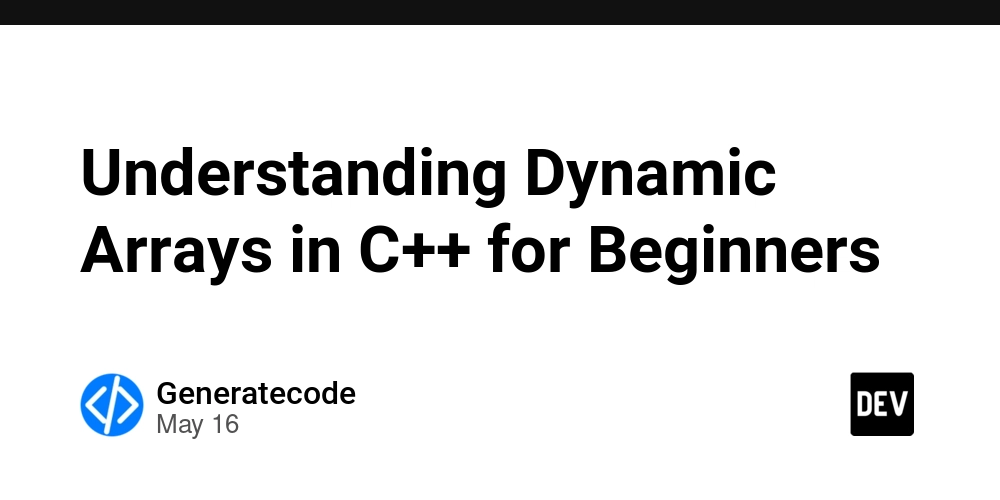Understanding Dynamic Arrays in C++ for Beginners
As a beginner in coding, it's perfectly natural to have questions about how things work, especially when dealing with dynamic arrays in C++. In your code, you have set up a dynamic array that can grow as needed, and you're using a couple of key concepts to manage memory and data. Let's dive into your questions and break down how your code operates, while also discussing the underlying principles of dynamic memory allocation in C++. How Does the Dynamic Array Resize Work? You mentioned that you set the initial size of the array to 5 and that it can increase to 10, yet you are able to store up to 20 numbers. This is a great point of confusion for newcomers. The way your code works involves both the capacity variable and the dynamic allocation of memory. Dynamic Memory Allocation Initially, you allocate memory for 5 integers with the line: int* numbers = new int[capacity]; This creates an array numbers that can hold up to 5 integers. As you collect user input, if the number of integers exceeds this capacity, your code dynamically resizes the array by creating a new, larger array: int* morenumbers = new int[2*capacity]; When you fill the new array with existing values and replace the old array with this new one, you then double the size of the capacity from 5 to 10. Since you haven't set an upper limit on how many times this resizing can occur, theoretically, there's no limit to the number of integers you can enter until you run out of system memory. The Importance of Dynamic Resizing This dynamic resizing is a fundamental aspect of how many container data structures work in C++, such as std::vector. Your approach allows for capturing a growing number of inputs by continually transferring data to larger memory blocks as needed. Understanding Variable Scope in C++ Your second question revolves around the index variable and its scope. Let's clarify a few things about variable scope in C++. Variable Scope Explained In C++, the variable scope usually dictates where a variable can be accessed. If you declare a variable within a function, it retains its value even if the control flow leaves the specific block, assuming it doesn’t go out of the scope of the function itself. In your case: int index=0; This declaration is on the same level as your main function and is not confined to the while loop. Consequently, the index variable exists for the entire duration of the main() function, allowing you to access it later in your program, such as for printing the values collected. Why it Works So, when your index changes as you collect user input, you are adjusting its value but not leaving its scope. When the outer for loop eventually executes, it will accurately reflect how many valid numbers were stored in the numbers array, using that same index value: for (int i = 0; i < index; i++) cout

As a beginner in coding, it's perfectly natural to have questions about how things work, especially when dealing with dynamic arrays in C++. In your code, you have set up a dynamic array that can grow as needed, and you're using a couple of key concepts to manage memory and data. Let's dive into your questions and break down how your code operates, while also discussing the underlying principles of dynamic memory allocation in C++.
How Does the Dynamic Array Resize Work?
You mentioned that you set the initial size of the array to 5 and that it can increase to 10, yet you are able to store up to 20 numbers. This is a great point of confusion for newcomers. The way your code works involves both the capacity variable and the dynamic allocation of memory.
Dynamic Memory Allocation
Initially, you allocate memory for 5 integers with the line:
int* numbers = new int[capacity];
This creates an array numbers that can hold up to 5 integers. As you collect user input, if the number of integers exceeds this capacity, your code dynamically resizes the array by creating a new, larger array:
int* morenumbers = new int[2*capacity];
When you fill the new array with existing values and replace the old array with this new one, you then double the size of the capacity from 5 to 10. Since you haven't set an upper limit on how many times this resizing can occur, theoretically, there's no limit to the number of integers you can enter until you run out of system memory.
The Importance of Dynamic Resizing
This dynamic resizing is a fundamental aspect of how many container data structures work in C++, such as std::vector. Your approach allows for capturing a growing number of inputs by continually transferring data to larger memory blocks as needed.
Understanding Variable Scope in C++
Your second question revolves around the index variable and its scope. Let's clarify a few things about variable scope in C++.
Variable Scope Explained
In C++, the variable scope usually dictates where a variable can be accessed. If you declare a variable within a function, it retains its value even if the control flow leaves the specific block, assuming it doesn’t go out of the scope of the function itself. In your case:
int index=0;
This declaration is on the same level as your main function and is not confined to the while loop. Consequently, the index variable exists for the entire duration of the main() function, allowing you to access it later in your program, such as for printing the values collected.
Why it Works
So, when your index changes as you collect user input, you are adjusting its value but not leaving its scope. When the outer for loop eventually executes, it will accurately reflect how many valid numbers were stored in the numbers array, using that same index value:
for (int i = 0; i < index; i++)
cout << numbers[i] << endl;
Conclusion
Understanding how dynamic memory allocation and variable scope work in C++ is fundamental to improving your coding skills. Your program successfully allows for array resizing and accessing your variable across different scopes. As you continue to learn, these concepts will serve as a key building block for more complex programming tasks.
Frequently Asked Questions
Can I limit the number of elements in the dynamic array?
Yes, you can add a maximum count check in your input loop but doing so would defy the purpose of using dynamic memory aimed at flexibility.
What happens if I don't use delete[] to free up memory?
Failing to use delete[] to release the allocated memory can lead to memory leaks, which can degrade performance or crash your program when the system runs out of memory.
How can I optimize my dynamic array implementation?
Once you're comfortable with basic concepts, consider using std::vector, which manages dynamic sizing and memory management for you, making your code cleaner and safer.
In summary, your code is functionally sound and beautifully illustrates how dynamic arrays work in C++. Keep exploring these concepts, and your understanding will deepen over time!
































































